View in other NatureServe Network Field Guides
NatureServe
Montana
Utah
Wyoming
Idaho
Wisconsin
British Columbia
South Carolina
Yukon
California
New York
Eastern Comma - Polygonia comma
Native Species
Global Rank:
G5
State Rank:
SU
Agency Status
USFWS:
USFS:
BLM:
External Links
General Description
[From Ferris and Brown 1981; Scott 1986; Glassberg 2001] Forewing 2.4-2.9 cm. Relatively small. Stubby tail-like projections on hindwing margin; upper surface orange-brown and dark brown with darker spots and patches, dorsal forewing lacks small subapical black bar and the apex two-toned, dorsal hindwing primarily black (summer form ) or orange with black spots ("winter" form), dark border on hindwing encloses pale spots and is broader than forewing border; under surface brown toned, ventral hindwing with very jagged black postmedian line below silver or white comma mark, the comma swollen on both ends.
Phenology
Two flights in much of range; April to August, the second in August and overwintering to May as adults (Bitzer and Shaw 1983; Glassberg 2001). Probably one flight in Manitoba and Maine, July and overwintering until June; three flights in the southeastern US (Scott 1986).
Diagnostic Characteristics
Best told by combination of the dorsal forewing lacking small subapical black bar and the apex two-toned, dark border on dorsal hindwing encloses pale spots and is broader than forewing border, ventral hindwing with very jagged black postmedian line below silver or white comma mark, the comma swollen on both ends.
Species Range
Montana Range
Range Descriptions
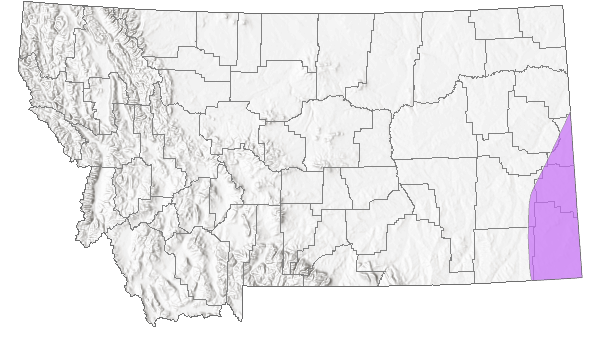
 Native
Native
Range Comments
Throughout North America east of the western Great Plains, from southern Canada (southeastern Saskatchewan to the Atlantic coast of Quebec) south to the Gulf Coast of Texas and northern Florida. Vagrants appear west of the normal range and barely reach Montana and Colorado (Ferris and Brown 1981; Scott 1986; Glassberg 2001). In Montana, one record (as of 2016) in 1998 near Ekalaka, Carter County, in the extreme southeastern corner of the state. Rare to uncommon outside the eastern US (Glassberg 2001).
Observations in Montana Natural Heritage Program Database
Number of Observations: 2
(Click on the following maps and charts to see full sized version)
Map Help and Descriptions
Relative Density
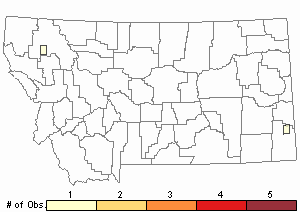
Recency
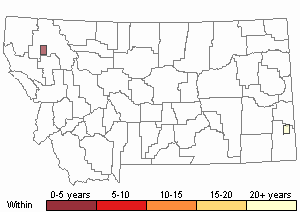
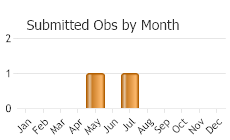
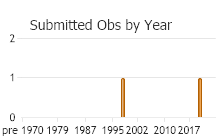
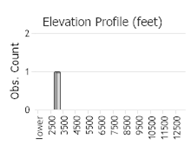 (Observations spanning multiple months or years are excluded from time charts)
(Observations spanning multiple months or years are excluded from time charts)
Migration
Non-migratory. Vagrants sometimes appear west of the normal range (Scott 1986).
Habitat
Urban parks, riparian woodlands, swamps, marshes, oldfields, hop fields (Ferris and Brown 1981; Bitzer and Shaw 1983; Scott 1986). Habitat in Montana not described.
Food Habits
Larval food plants include Althaea, Amboris, Ambrosia, Boehmeria, Celtis, Humulus, Laportea, Ulmus, and Urtica. Adults feed on flower nectar (including Acer, Asclepias, Chrysanthemum, Cirsium), rotting fruit, sap, and carrion (Reed 1958; Ferris and Brown 1981: Scott 1986, 2014; Tooker et al. 2002).
Reproductive Characteristics
Females lays eggs singly or stacked (up to 9 in a pile) on underside of host plant leaves or stems; larvae feed at night, usually are solitary, later instars live under a leaf with edges curled down and held in place with silk. Hibernate (overwinter) as adults. After spring emergence from hibernation (March and April in Iowa), males perch in mid-afternoon on flat ground or side branches of trees to pursue females, sometimes patrolling area around perches but usually not (Ferris and Brown 1981; Bitzer and Shaw 1983; Scott 1986)
Stewardship Responsibility
References
- Literature Cited AboveLegend:
 View Online Publication
View Online Publication Bitzer, R.J. and K.C. Shaw. 1983. Territorial behavior of Nymphalis antiopa and Polygonia comma (Nymphalidae). Journal of the Lepidopterists' Society 37:1-13.
Bitzer, R.J. and K.C. Shaw. 1983. Territorial behavior of Nymphalis antiopa and Polygonia comma (Nymphalidae). Journal of the Lepidopterists' Society 37:1-13. Ferris, C.D. and F.M. Brown (eds). 1981. Butterflies of the Rocky Mountains. Univ. of Oklahoma Press. Norman. 442 pp.
Ferris, C.D. and F.M. Brown (eds). 1981. Butterflies of the Rocky Mountains. Univ. of Oklahoma Press. Norman. 442 pp. Glassberg, J. 2001. Butterflies through Binoculars: A Field Guide to the Butterflies of Western North America. Oxford University Press.
Glassberg, J. 2001. Butterflies through Binoculars: A Field Guide to the Butterflies of Western North America. Oxford University Press. Kohler, S. 1980. Checklist of Montana Butterflies (Rhopalocera). Journal of the Lepidopterists' Society 34(1): 1-19.
Kohler, S. 1980. Checklist of Montana Butterflies (Rhopalocera). Journal of the Lepidopterists' Society 34(1): 1-19. Reed, H.B., Jr. 1958. A study of dog carcass communities in Tennessee, with special reference to the insects. American Midland Naturalist 59(1): 213-245.
Reed, H.B., Jr. 1958. A study of dog carcass communities in Tennessee, with special reference to the insects. American Midland Naturalist 59(1): 213-245. Scott, J.A. 1986. The butterflies of North America: a natural history and field guide. Stanford University Press, Stanford, California.
Scott, J.A. 1986. The butterflies of North America: a natural history and field guide. Stanford University Press, Stanford, California. Scott, J.A. 2014. Lepidoptera of North America 13. Flower visitation by Colorado butterflies (40,615 records) with a review of the literature on pollination of Colorado plants and butterfly attraction (Lepidoptera: Hersperioidea and Papilionoidea). Contributions of the C.P. Gillette Museum of Arthopod Diversity. Fort Collins, CO: Colorado State University. 190 p.
Scott, J.A. 2014. Lepidoptera of North America 13. Flower visitation by Colorado butterflies (40,615 records) with a review of the literature on pollination of Colorado plants and butterfly attraction (Lepidoptera: Hersperioidea and Papilionoidea). Contributions of the C.P. Gillette Museum of Arthopod Diversity. Fort Collins, CO: Colorado State University. 190 p. Tooker, J.F., P.F. Reagel, and L.M. Hanks. 2002. Nectar sources of day-flying lepidoptera of central Illinois. Annals of the Entomological Society of America 95(1): 84-96.
Tooker, J.F., P.F. Reagel, and L.M. Hanks. 2002. Nectar sources of day-flying lepidoptera of central Illinois. Annals of the Entomological Society of America 95(1): 84-96.
- Additional ReferencesLegend:
 View Online Publication
View Online Publication
Do you know of a citation we're missing? Allen, T.J., J.P. Brock, and J. Glassberg. 2005. Caterpillars in the field and garden: a field guide to the butterfly caterpillars of North America. Oxford University Press.
Allen, T.J., J.P. Brock, and J. Glassberg. 2005. Caterpillars in the field and garden: a field guide to the butterfly caterpillars of North America. Oxford University Press. Brock, J.P. and K. Kaufman. 2003. Kaufman Field Guide to Butterflies of North America. Houghton Mifflin Company, New York, NY 284 pp.
Brock, J.P. and K. Kaufman. 2003. Kaufman Field Guide to Butterflies of North America. Houghton Mifflin Company, New York, NY 284 pp. Forister, M.L., E.M. Grames, C.A. Halsch, K.J. Burls, C.F. Carroll, K.L. Bell, J.P. Jahner, et al. 2023. Assessing risk for butterflies in the context of climate change, demographic uncertainty, and heterogeneous data sources. Ecological Monographs 93(3):e1584. https://doi.org/10.1002/ecm.1584
Forister, M.L., E.M. Grames, C.A. Halsch, K.J. Burls, C.F. Carroll, K.L. Bell, J.P. Jahner, et al. 2023. Assessing risk for butterflies in the context of climate change, demographic uncertainty, and heterogeneous data sources. Ecological Monographs 93(3):e1584. https://doi.org/10.1002/ecm.1584 Layberry, R.A., P.W. Hall, and J.D. LaFontaine. 1998. The Butterflies of Canada. University of Toronto Press. 280 pp. + color plates.
Layberry, R.A., P.W. Hall, and J.D. LaFontaine. 1998. The Butterflies of Canada. University of Toronto Press. 280 pp. + color plates. Stanford, R.E. and P.A. Opler. 1993. Atlas of western USA butterflies: including adjacent parts of Canada and Mexico. Unpubl. Report. Denver and Fort Collins, Colorado 275 pp.
Stanford, R.E. and P.A. Opler. 1993. Atlas of western USA butterflies: including adjacent parts of Canada and Mexico. Unpubl. Report. Denver and Fort Collins, Colorado 275 pp.
- Web Search Engines for Articles on "Eastern Comma"
- Additional Sources of Information Related to "Insects"





